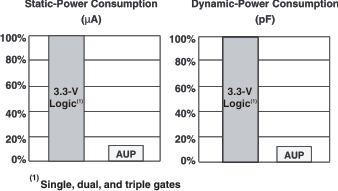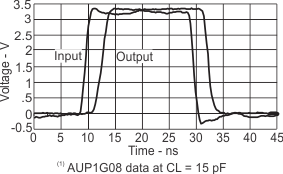SCES596G JULY 2004 – August 2017 SN74AUP1G126
PRODUCTION DATA.
- 1 Features
- 2 Applications
- 3 Description
- 4 Revision History
- 5 Pin Configuration and Functions
-
6 Specifications
- 6.1 Absolute Maximum Ratings
- 6.2 ESD Ratings
- 6.3 Recommended Operating Conditions
- 6.4 Thermal Information
- 6.5 Electrical Characteristics
- 6.6 Switching Characteristics: CL = 5 pF
- 6.7 Switching Characteristics: CL = 10 pF
- 6.8 Switching Characteristics: CL = 15 pF
- 6.9 Switching Characteristics: CL = 30 pF
- 6.10 Operating Characteristics
- 6.11 Typical Characteristics
- 7 Parameter Measurement Information
- 8 Detailed Description
- 9 Application and Implementation
- 10Power Supply Recommendations
- 11Layout
- 12Device and Documentation Support
- 13Mechanical, Packaging, and Orderable Information
9 Application and Implementation
NOTE
Information in the following applications sections is not part of the TI component specification, and TI does not warrant its accuracy or completeness. TI’s customers are responsible for determining suitability of components for their purposes. Customers should validate and test their design implementation to confirm system functionality.
9.1 Application Information
The SN74AUP1G126 device is an output enabled CMOS buffer that can be used in LED indicator applications that require less than 4 mA. The device can produce up to 4 mA of drive current at 3.3 V. The inputs to the device are also overvoltage tolerant up to 3.6 V, allowing it to translate down to any valid VCC.
9.2 Typical Application
 Figure 6. Application Schematic with MCU driving an LED Indicator
Figure 6. Application Schematic with MCU driving an LED Indicator
9.2.1 Design Requirements
This device uses CMOS technology and has balanced output drive. Take care to avoid bus contention because it can drive currents that would exceed maximum limits. The output drive strength of this device creates fast edges into light loads so routing and load conditions should be considered to prevent ringing.
9.2.2 Detailed Design Procedure
- Recommended Input Conditions
- Rise time and fall time specs. See (Δt/ΔV) in the Recommended Operating Conditions table.
- Specified high and low levels. See (VIH and VIL) in the Recommended Operating Conditions table.
- Inputs are overvoltage tolerant allowing them to go as high as (VI max) in the Recommended Operating Conditions table at any valid VCC.
- Recommended Output Conditions
- Load currents should not exceed (IO max) per output and should not exceed (Continuous current through VCC or GND) total current for the part. These limits are located in the Absolute Maximum Ratings table.
- Outputs should not be pulled above VCC.
9.2.3 Application Curves
 Figure 7. AUP – The Lowest-Power Family
Figure 7. AUP – The Lowest-Power Family
 Figure 8. Excellent Signal Integrity
Figure 8. Excellent Signal Integrity